MARIANI’S
Virtual Gourmet
May 12,
2019
NEWSLETTER
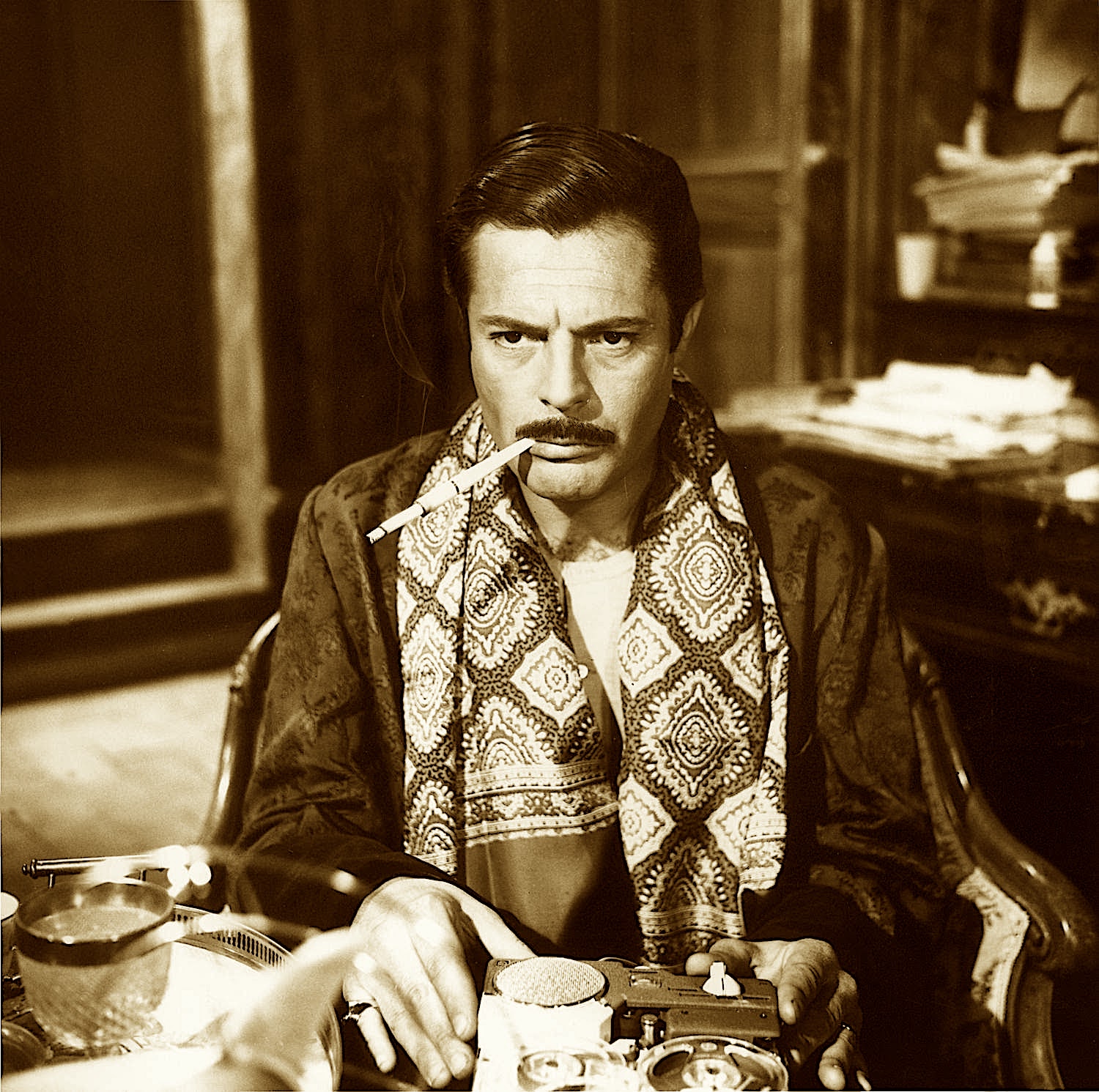
❖❖❖
IN THIS ISSUE
STAYING AND DINING IN LAUSANNE
By John Mariani
NEW YORK CORNER
ARETSKY'S PATROON
By John Mariani
NOTES FROM THE WINE CELLAR
RAMON BILBAO
By John Mariani
❖❖❖
STAYING AND DINING IN LAUSANNE
By John Mariani

The Hotel Royal Savoy
Photo: Robert Miller
It would actually be difficult to find a dining room table in Lausanne that does not have a glorious view of Lake Leman and the Alps. Certainly, restaurant and hotel owners know how to take advantage of this, one of the most romantic vistas in Europe.
(Prices below are in Swiss francs, which at the moment are nearly at parity with the U.S. dollar. VAT and service are included.)
LAUSANNE PALACE
Rue du Grand Chêne 7-9
+41 (0)21 331 31 31
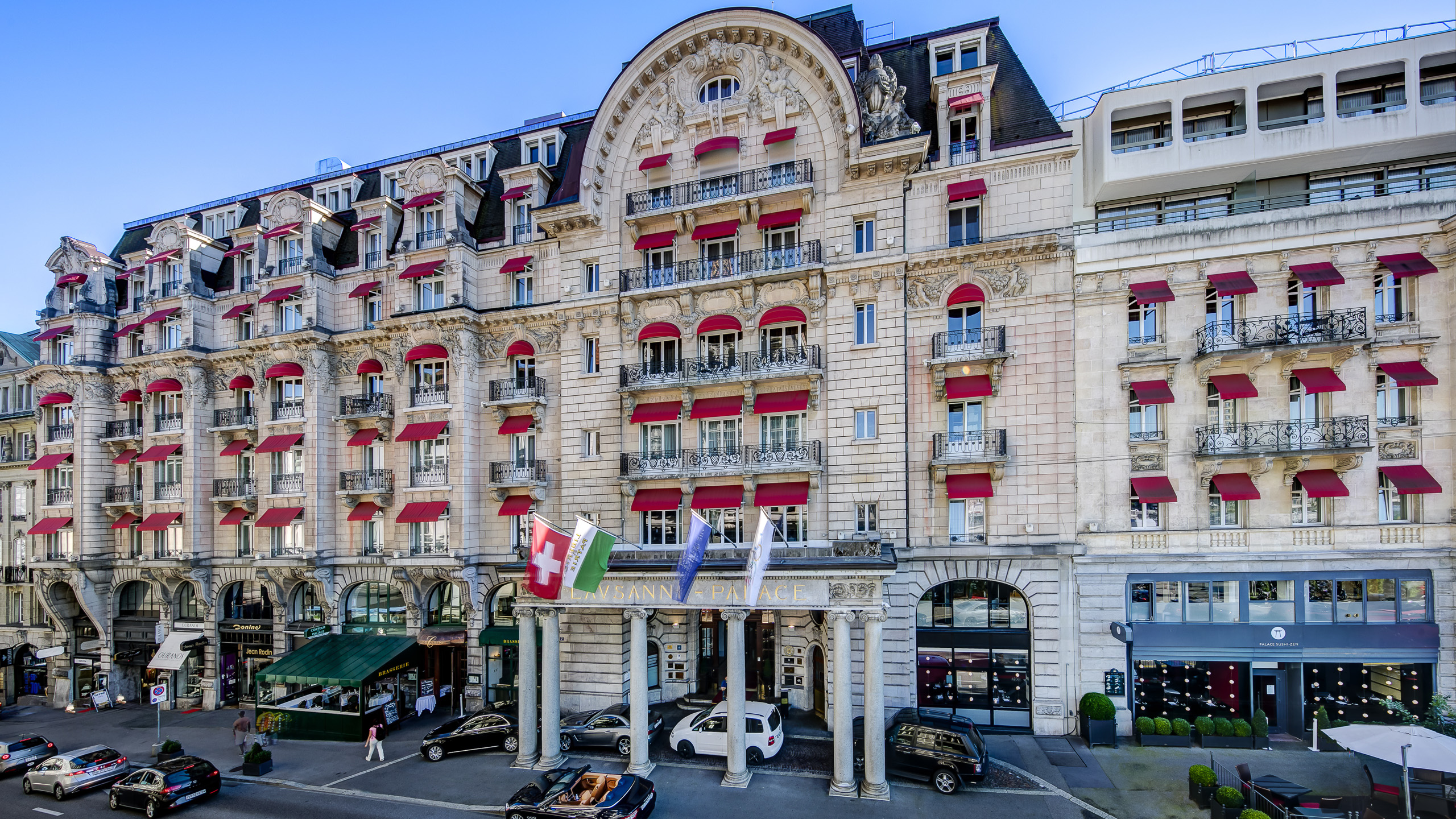 The
grand Belle
Epoque building and garden take up a lot of ground
in the middle of the city,
yet the hotel has only 140 rooms, with 44 suites.
Opened in 1915, it has long
served as the official hotel of the International
Olympic Committee and has a
large complement of business travelers who
appreciate the quiet ambiance and
privacy afforded them.
The
grand Belle
Epoque building and garden take up a lot of ground
in the middle of the city,
yet the hotel has only 140 rooms, with 44 suites.
Opened in 1915, it has long
served as the official hotel of the International
Olympic Committee and has a
large complement of business travelers who
appreciate the quiet ambiance and
privacy afforded them.
La Brasserie Grand
Chêne, serving classic Parisian fare and plats du
jour, is open throughout the
day, and the Bar 1915 and Havana Cigar Bar are as
popular with 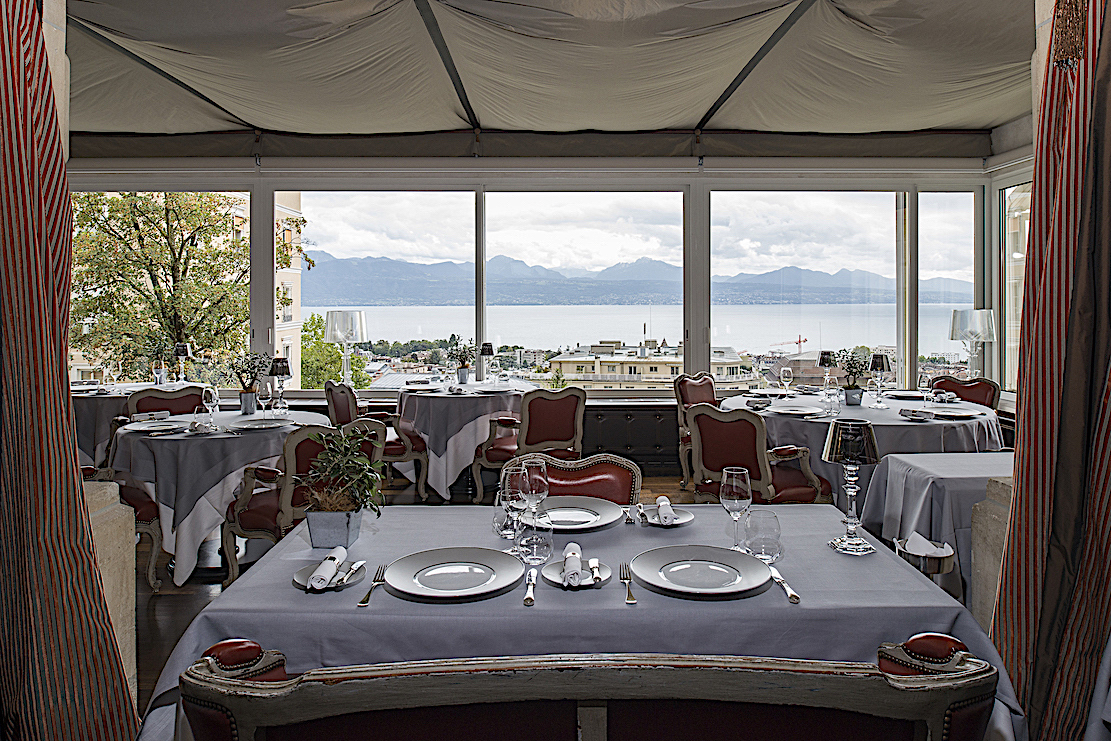 locals as
with
visitors. La Côte Jardin is a Mediterranean
restaurant with a wonderful
verandah, and Sushi Zen—unusual for a Lausanne
hotel—is considered one of the city's finest
Japanese
restaurants.
locals as
with
visitors. La Côte Jardin is a Mediterranean
restaurant with a wonderful
verandah, and Sushi Zen—unusual for a Lausanne
hotel—is considered one of the city's finest
Japanese
restaurants.
But the hotel’s
most illustrious restaurant is La Table d’Edgard (below), under
Chef Edgard Bovier and
young Chef de Cuisine Andres Arocena (he’s from
the Basque country and worked
under Martin Arzak). The menu is Iberian and
Mediterranean, beginning with
bite-sized tapas of jabugo
bellota
ham and ricotta with truffled parmesan; pissaladière
flatbread with an aïoli, and an unexpected Indian
samosa
pastries of juicy beef cheeks confit. Lobster “primavera”
comes with fresh peas and stuffed zucchini flowers
(below).
For the main
part of the meal Arocena uses springtime’s most
tender asparagus paired with red Sicilian shrimp
and lemon dressing,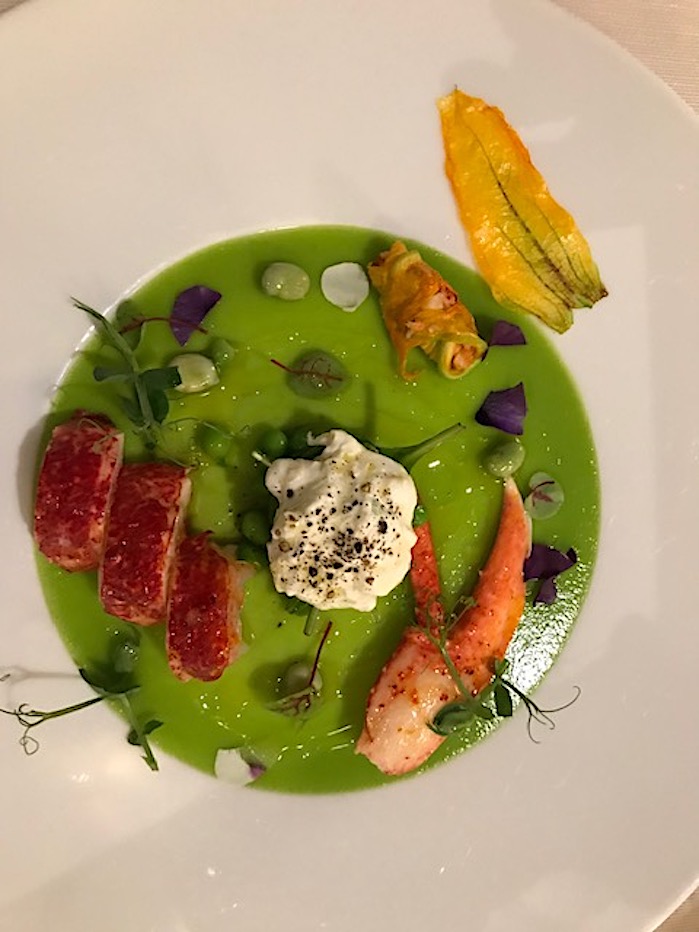 while
crispy langoustines come with a zucchini flower
soufflé containing a fish
mousse. Plump
morels are stuffed
with mashed potatoes, garlic and orange, while
ravioli are plumped with mackerel
and accompanied by squid ink crêpes. Porchetta is
suckling
pig, long roasted to achieve a crunchy skin and
milky flesh,
accompanied by a sweet-sour kumquat condiment; and
beef is enhanced with creamy
burrata cheese, foie gras and black truffles and
creamed potatoes.
while
crispy langoustines come with a zucchini flower
soufflé containing a fish
mousse. Plump
morels are stuffed
with mashed potatoes, garlic and orange, while
ravioli are plumped with mackerel
and accompanied by squid ink crêpes. Porchetta is
suckling
pig, long roasted to achieve a crunchy skin and
milky flesh,
accompanied by a sweet-sour kumquat condiment; and
beef is enhanced with creamy
burrata cheese, foie gras and black truffles and
creamed potatoes.
Everything had the brightness and freshness of dishes obviously made à la minuit, and, over a ten-day visit to Switzerland, this was one of the finest, most inventive dinners I had.
There
are three
menus, a prix fixe at CHF78, a “Mediterranean Sun”
dinner at CHF145 and a
“Signature Menu” at CHF185. (Wine pairings
available at extra cost.)
HOTEL
ROYAL SAVOY LAUSANNE
Avenue d'Ouchy
41 21 614 88 88
Opened in 1909, the Royal Savoy, done in a spirited Art Nouveau style, was bought in 2009 by Qatar-based Katara Hospitality and underwent a much-needed five-year renovation, to re-open in 2015 with 196 rooms, indoor and outdoor pools and spa, so that it is now as up-to-date as any hotel in Europe. For years the Spanish royal family stayed there while in exile; these days everyone comes and goes as they please.
The Brasserie du Royal is composed of four
connected dining venues, all featuring the food
and wines of the Vaud region.
The 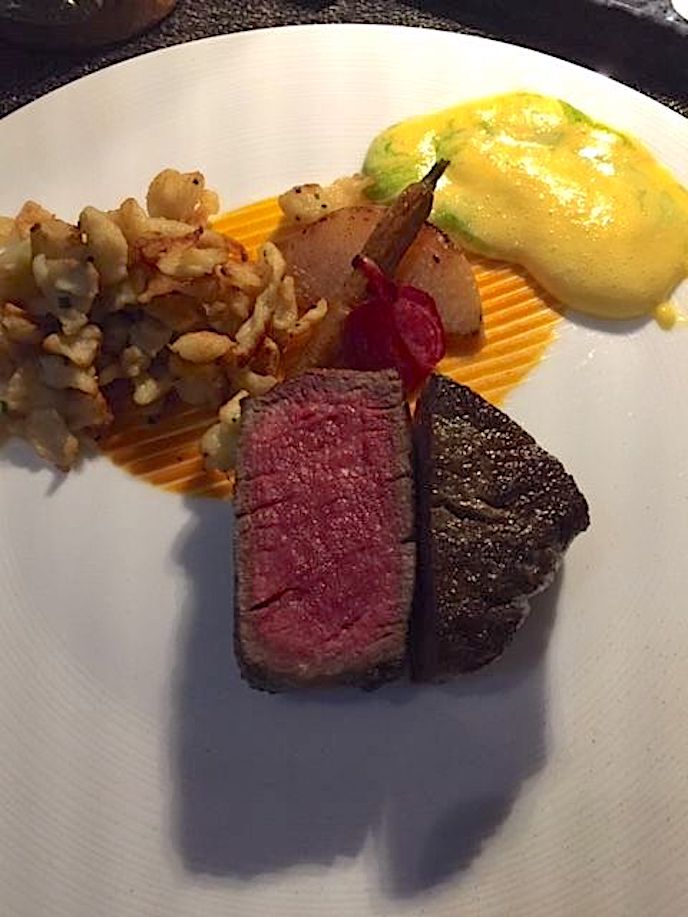 Lounge Bar
and Lobby Bar are pleasantly secluded and open for
breakfast and
all-day dining, and in the Sky Lounge
international cuisine is offered from
noon till midnight.
Lounge Bar
and Lobby Bar are pleasantly secluded and open for
breakfast and
all-day dining, and in the Sky Lounge
international cuisine is offered from
noon till midnight.
The Brasserie du Royal’s signature fine dining restaurant is overseen by renowned Strasbourg chef Marc Haeberlin, of Auberge de L’Ill, with a menu that evokes many of the famous dishes of that longstanding three-star restaurant. You approach the restaurant through a hall leading to a temperature-controlled vitrine, where Executive Chef Sebastian Cassagnol proudly shows off the grass-fed beef and meats aging for up to four weeks, which includes tenderloin, prime rib, veal flank and Angus ribeye.
You then enter a room in soft colors of gray
and beige, the lighting fairly low.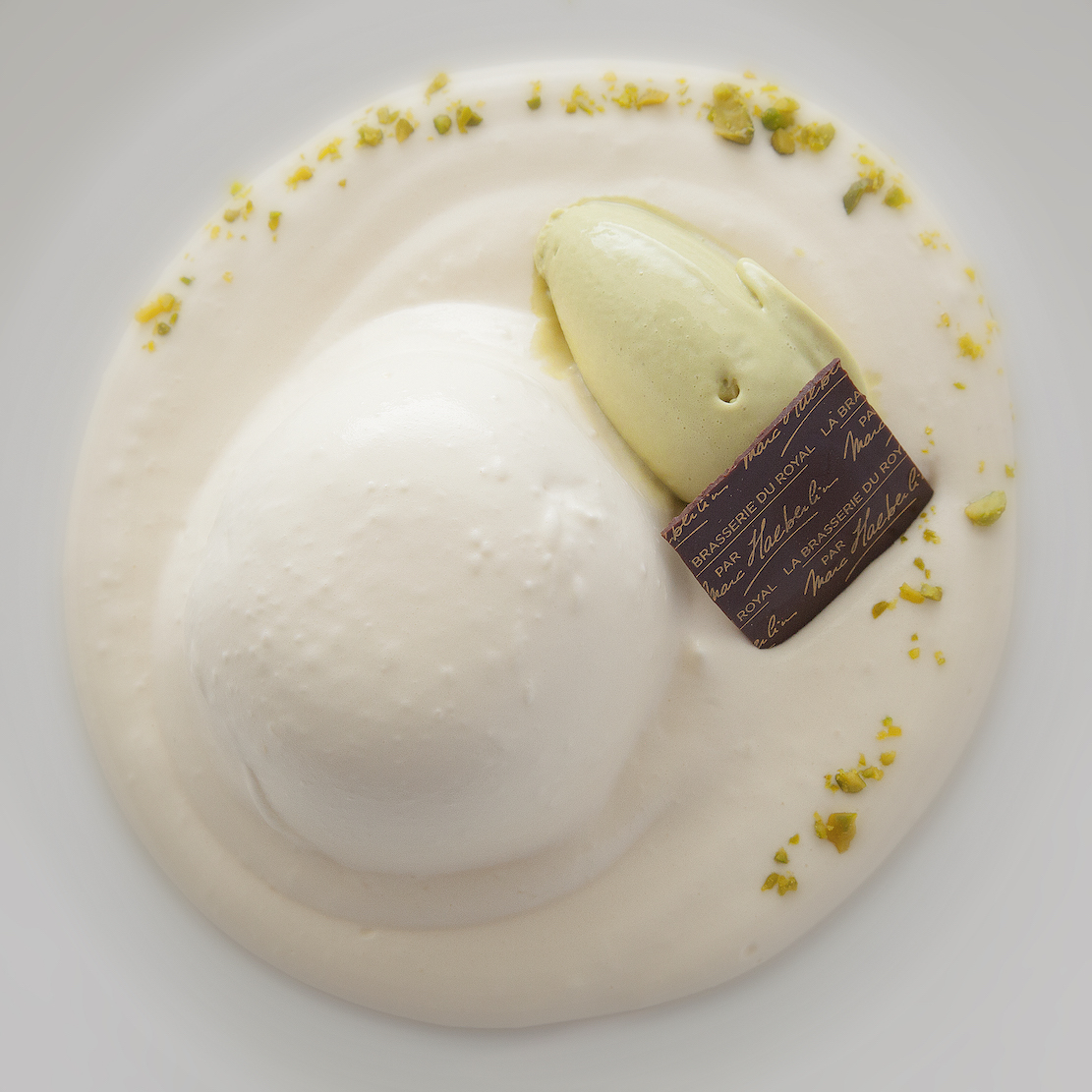 My wife
and I chose a menu that began with
scallops and leeks and creamy risotto with
truffles, foie gras and butter—an
exceptionally rich dish very much in the Haeberlin
style. Our main courses
included Swiss beef and a chicken breast with a “carbonara” of celery. Dessert was a
strawberry tart with almond
cream and a scent of tarragon with strawberry
sorbet; and a preserved “Pear
Haeberlin” in a Champagne zabaglione and pistachio
ice cream (right).
My wife
and I chose a menu that began with
scallops and leeks and creamy risotto with
truffles, foie gras and butter—an
exceptionally rich dish very much in the Haeberlin
style. Our main courses
included Swiss beef and a chicken breast with a “carbonara” of celery. Dessert was a
strawberry tart with almond
cream and a scent of tarragon with strawberry
sorbet; and a preserved “Pear
Haeberlin” in a Champagne zabaglione and pistachio
ice cream (right).
By the way, the wine list at the Brasserie is rich with Swiss bottlings. Sommelier Vincent Planche says that “Out of 270 different wines on our list, 70 percent are Swiss and 70 percent of those are from the local Vaud region.” The hotel also uniquely offers a “Vintage Lavaux” package that features an excursion to a local Lavaux vineyard, a picnic lunch with the winemaker and a wine and chocolate pairing. The one-night package starts at CHF1,220 for two people.
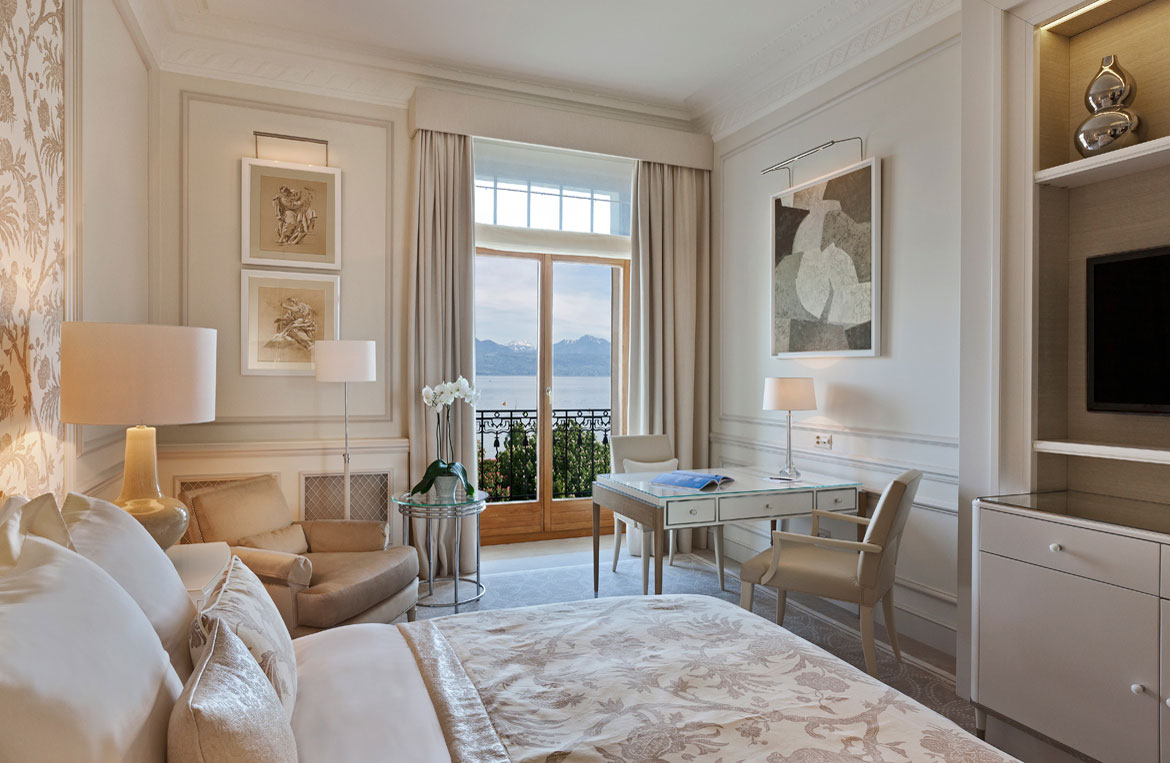 BEAU
RIVAGE
BEAU
RIVAGE
Chemin de Beau-Rivage 21
+41 21 613 33 33
The
Beau Rivage is
one of Lausanne’s oldest grand hotels, dating to
1861, and its impressive
straddling of the waterfront gives its colonnaded
terraces glorious views of
the passage of time and light on the lake and
mountains throughout the day. You
may dine on these terraces at lunch and at
twilight, which is particularly
romantic as the skies turn myriad shades of orange
and violet.
The great lobby, with its huge marble
columns and vast corridors connecting the hotel’s
wings, is as impressive as
any in Europe.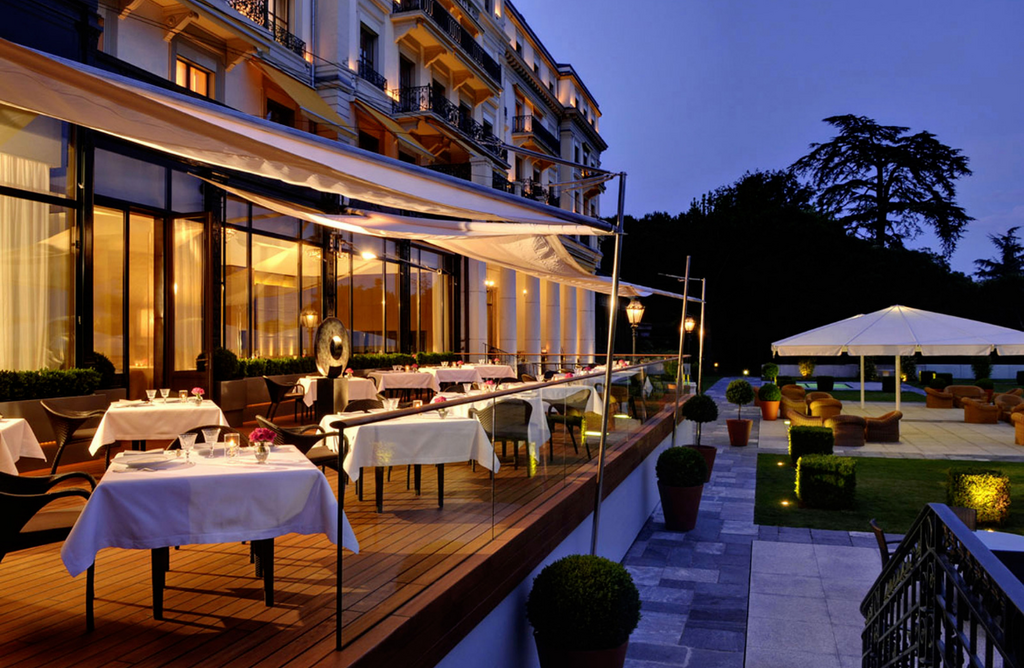
All the rooms were renovated between 2012 and 2014 by interior designer Pierre-Yves Rochon in soft pastels with careful placement of mirrors.
The hotel has an extensive array of children’s activities too, from a treasure hunt to pastry making and a tour of the hotel behind the scenes.
Aside from
breakfast, I did not have a chance to dine at the
Beau Rivage, but it is worth
noting that their main dining room is under the
helm of noted French chef
Anne-Sophie Pic (right),
whose own restaurant in Valence has three Michelin
stars. On-premises
chef de cuisine is Paolo
Boscaro, who has earned two stars for Beau Rivage.
There is a business lunch
menu at CHF95, an “Emotion” menu at CHF260 and a
Pic Collection at CHF350.
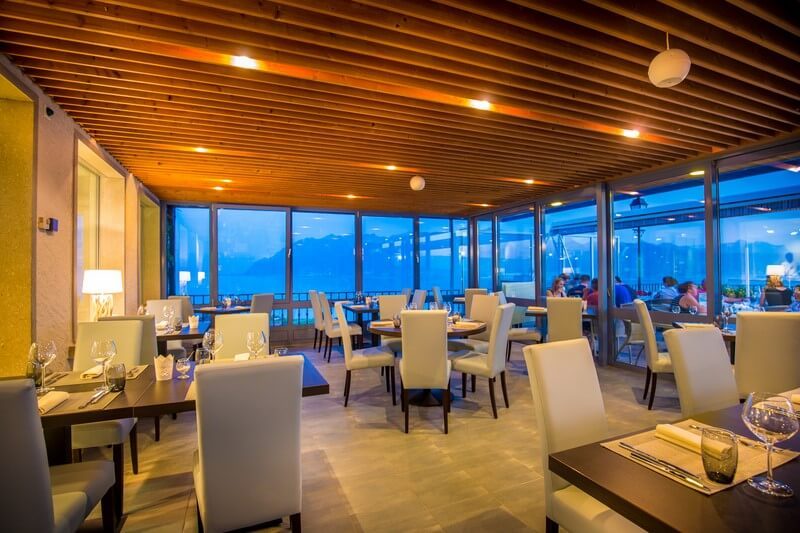 TOUT UN MONDE
TOUT UN MONDE
Place du Village 7
Bourg-en-Lavaux
Just fifteen
minutes from Lausanne, in the Vaud wine country
that rambles in terraces down
to the lake, is a darling small restaurant named
Tout un Monde hovering above
the vineyards on a kind of promontory in the
little village of Bourg-en-Lavaux.
Chef Yohann Magne cooks very much from the
provender in the area in a lovely
dining room enclosed by glass, all kept running
with simple grace by
partner
Celine Gsponer. It’s an ideal getaway from the
city and a chance to visit a
vineyard and then have a lunch that is guided by
what those estates provide.
We had a leisurely lunch there, beginning with little pastry balls with baby spinach called malekoff, followed by a risotto with lake trout and a surprising sprinkling of popcorn. Boutefass was a hearty sausage of pork, carrots and herbs with potato gratin, and there was an equally homey rabbit stew with polenta. Dessert was a cold coconut mousse and a classic poire Belle-Helene. There are daily specials at lunch with recommended Lavaux wines.
Menus are à la carte, with main courses averaging CHF45, with a set menu at CHF59.
❖❖❖
By John Mariani
Photos by Dan Krieger
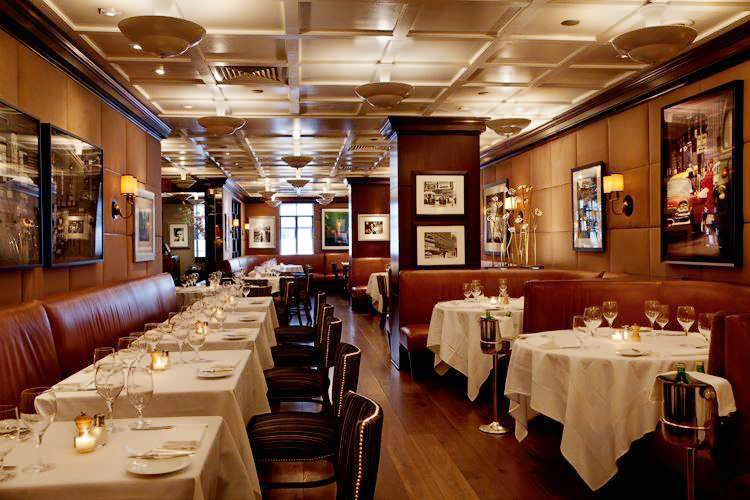
The idea that a chef or restaurateur should always be in his restaurant has for years been dismissed as out of touch with the way the industry now works.
 Thus,
chefs like David Chang and
Jean-Georges Vongerichten have joined the
ranks of TV celebs like Giada de
Laurentiis, Bobby Flay and Guy Fieri in simply
signing management contracts,
then going on to the next one, while
international steakhouse chains like Smith
& Wollensky, Ruth’s Chris, Palm and Del
Frisco’s open unit after unit with
little more than a commissary game plan and
chefs whose names you’ll never
hear. The name on the door in no way indicates
that person will be within a
thousand miles of the restaurant.
Thus,
chefs like David Chang and
Jean-Georges Vongerichten have joined the
ranks of TV celebs like Giada de
Laurentiis, Bobby Flay and Guy Fieri in simply
signing management contracts,
then going on to the next one, while
international steakhouse chains like Smith
& Wollensky, Ruth’s Chris, Palm and Del
Frisco’s open unit after unit with
little more than a commissary game plan and
chefs whose names you’ll never
hear. The name on the door in no way indicates
that person will be within a
thousand miles of the restaurant.
Ken Aretsky (left), as owner of Aretsky’s Patroon, which vies for the same carnivorous clientele as a slew of established New York East Side steakhouses, put his foot down, quite literally, by committing to being in his restaurant on a daily basis.
Aretsky
has been in the game for a long time now.
Starting in his family’s restaurant
supply business at 16, he opened his own
successful restaurant Truman’s on Long
Island in 1971. Eight years later he opened
Oren & Aretsky’s on
Manhattan’s Upper East Side, attracting a
considerable sports star clientele.
Next came the New America-style restaurant
Arcadia with chef Anne Rosenzweig at
a time, 1983, when there were virtually no
women chefs in New York.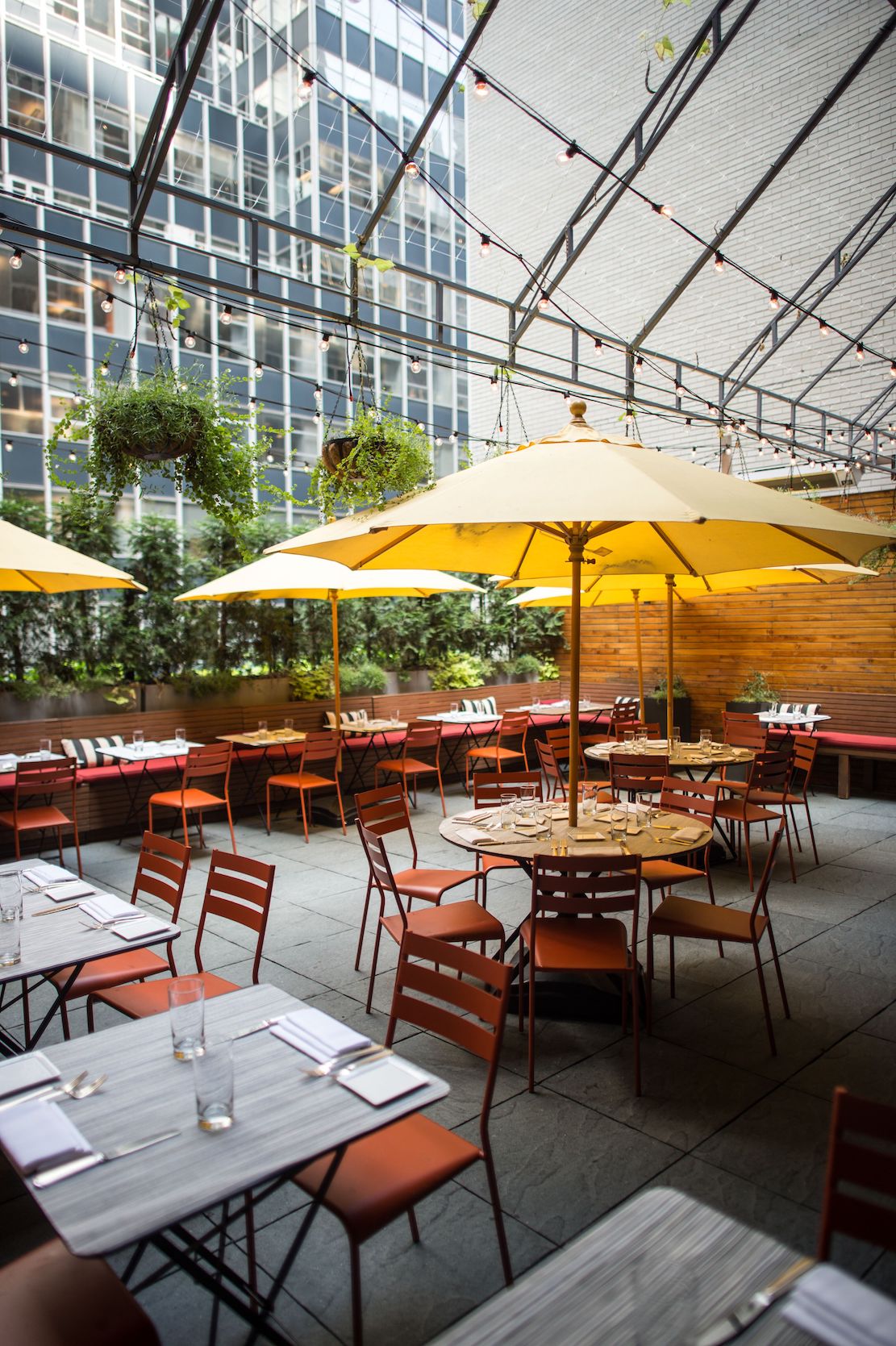 He then did
a ten-year stint as CEO of the ‛21’ Club, and
afterwards opened Butterfield 81.
He then did
a ten-year stint as CEO of the ‛21’ Club, and
afterwards opened Butterfield 81.
When the space that was previously a gritty, old-line steakhouse called Christ Cella became available in 1995, Aretsky and two partners took over the townhouse, naming it Patroon, after Dutch gentry who founded Manhattan. The first chef was Geoffrey Zakarian; the Times gave the restaurant three stars.
Ten years later Aretsky and his wife, Diane Lyne, bought out his partners and attached his last name to Patroon, “under the assumption that my earlier restaurant history might bring some additional customers.”
Now, on any given night, he knows at least a third of his guests, whom he cordially greets and schmoozes with. To add to the familiarity, maître d’ Stephane Legouill has logged 22 years at Patroon.
Given his longevity in a tough industry, Aretsky is considered by peers as one of the masters of form and substance. Always impeccably dressed—and it must kill him to allow men to be seated without jackets—Aretsky fits well among his clientele and knows what they expect, which is neither novelty nor pandering, and the restaurant’s décor of brown leather banquets, polished wood and classic black-and-white photographs of New York looks as fresh today as when Patroon debuted.
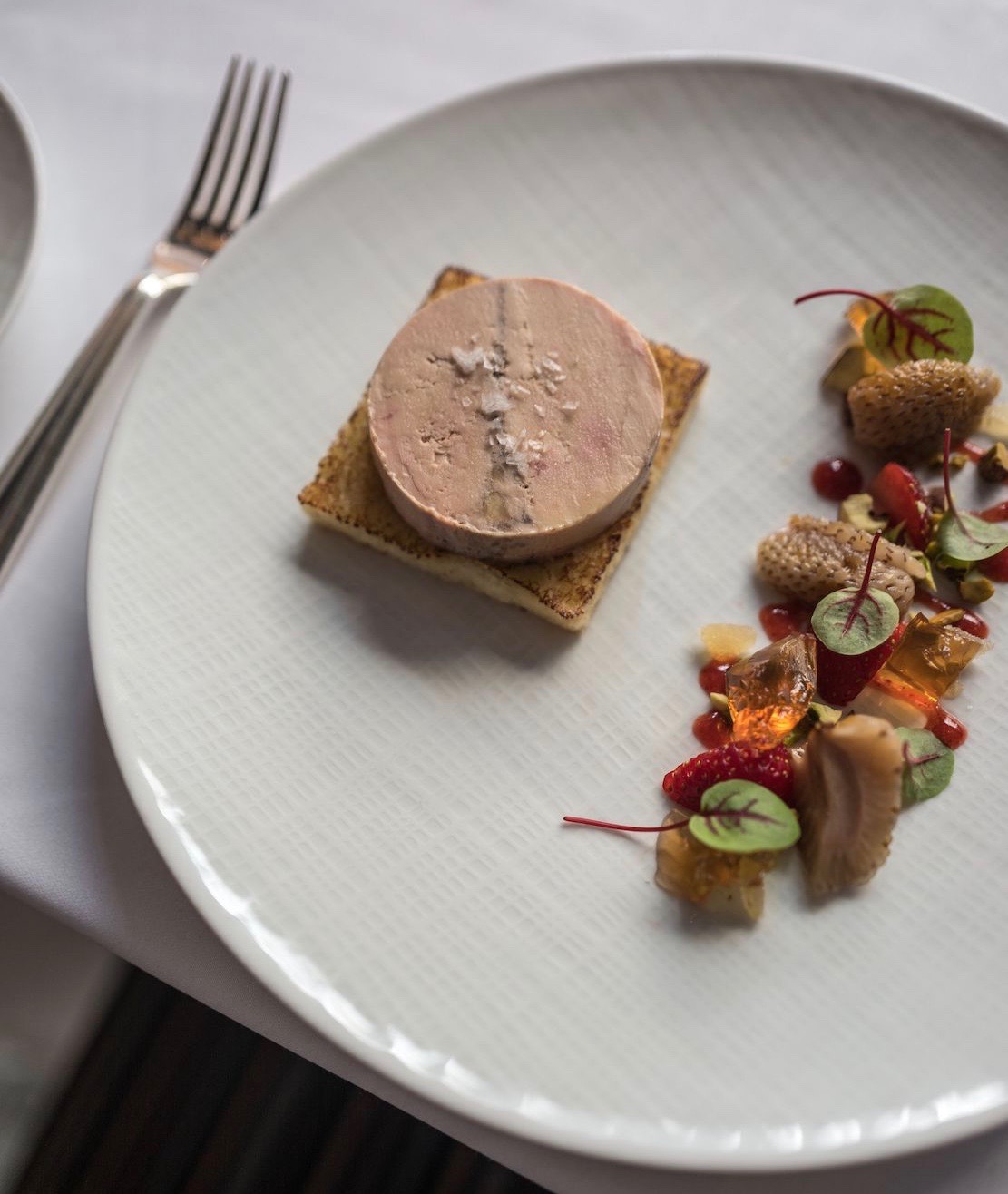 The
restaurant
maximizes its three floor-structure. The main
dining room is on the
first floor, private rooms on the second (a
cigar bar is history), and on the
third an open roof space (right).
“Although there is overlap, the rooftop bar
attracts
a young, professional clientele looking for
more casual after-work fun,” says
Aretsky. “The ability to offer a slider and a
cold beer under the summer skies,
or in the cozy enclosed winter roof, is an
advantage over the other restaurants
you mention. The roof also offers the best al
fresco lunchtime dining during
the summer months, as we are up two stories
from the sidewalk, so we offer a
bit more of a respite than the usual outdoor
scene.” Proximity to the U.N.
doesn’t hurt either. And on Fridays there is a
prix fixe dinner with live jazz,
which appeals largely to a neighborhood
clientele.
The
restaurant
maximizes its three floor-structure. The main
dining room is on the
first floor, private rooms on the second (a
cigar bar is history), and on the
third an open roof space (right).
“Although there is overlap, the rooftop bar
attracts
a young, professional clientele looking for
more casual after-work fun,” says
Aretsky. “The ability to offer a slider and a
cold beer under the summer skies,
or in the cozy enclosed winter roof, is an
advantage over the other restaurants
you mention. The roof also offers the best al
fresco lunchtime dining during
the summer months, as we are up two stories
from the sidewalk, so we offer a
bit more of a respite than the usual outdoor
scene.” Proximity to the U.N.
doesn’t hurt either. And on Fridays there is a
prix fixe dinner with live jazz,
which appeals largely to a neighborhood
clientele.
Originally, the menu was in the sacrosanct mold of New York steakhouses, like nearby Palm, Smith & Wollensky and Spark’s—none of them known for warmly greeting new customers. Aretsky realized that in such a competitive market, “Getting the food right is common sense, but getting service and the experience right is the utmost important factor in running a successful restaurant.”
Today
seven-year veteran chef Aaron Fitterman’s menu
slants away from the steakhouse
template.
You might begin with an
array of both East and West Coast oysters, but
there are also unusual additions
like chicken and foie gras meatballs with
apple and Calvados  chutney ($15) and arancini
rice balls with uni and a
jalapeño jelly ($18). Among recommended
appetizers, I often order the foie gras
torchon
(left)
with strawberry, ginger and pistachio on
brioche ($25), and the crab
cake contains plenty of jumbo lumps, with a
dressing of lobster tarragon aioli
($23).
chutney ($15) and arancini
rice balls with uni and a
jalapeño jelly ($18). Among recommended
appetizers, I often order the foie gras
torchon
(left)
with strawberry, ginger and pistachio on
brioche ($25), and the crab
cake contains plenty of jumbo lumps, with a
dressing of lobster tarragon aioli
($23).
Kudos to the kitchen for using American lamb for its rack with smoked eggplant, goat cheese polenta and grape tomato ($59), and I know of no New York steakhouse that has a confit of suckling pig on a nightly basis; here it comes with a mustard spaetzle, guindilla pepper and apple cider jus ($46).
In the New York market all the principal contenders can rightly claim they buy the best Prime beef available, and Aretsky’s Patroon is clearly in the big show. Its 40-day dry-aged ribeye not only has the enormous, mineral-rich flavor that distinguishes great aged Prime but also the perfect searing, carved tableside with pommes soufflé, tomato harissa jam, mushroom jus, grilled baby gem lettuce, black olive vinaigrette and massive marrow bones. It’s priced at $163 for two, but no other steakhouses in the area gives you even a single potato with their ribeye.
The menu also features crisp roast duck with cashew-apricot wild rice and grilled scallions ($49), and for seafood there’s steamed black cod with carrot dashi, soba noodle and enoki mushrooms ($42), and a two-pound smoked lobster Americaine with buttered pommes fondue and spinach ($78). So, too, Dover sole (below) gets an accompaniment of a butter-braised leek & roasted tomato tart ($72), so you’re not really going to need any side dishes, though it’s hard to turn down the spinach and lobster gratin with leek and tumbleweed cheddar ($16).
 Desserts
go well beyond the cheesecake-and-pecan-pie
formula, including a chestnut torte
with dark chocolate, whipped panna cotta,
spiced white chocolate and pear
sorbet ($14) and a Creamsicle baked Alaska
(for two) with pistachio cake,
buttermilk ice cream, tangerine sorbet and
Grand Marnier ($21).
Desserts
go well beyond the cheesecake-and-pecan-pie
formula, including a chestnut torte
with dark chocolate, whipped panna cotta,
spiced white chocolate and pear
sorbet ($14) and a Creamsicle baked Alaska
(for two) with pistachio cake,
buttermilk ice cream, tangerine sorbet and
Grand Marnier ($21).
If
you go to Aretsky’s Patroon, you’re going to
get a steak as fine as any in New
York and better than most anywhere outside of
it. But these days you get a good
deal more, not least the kind of hospitality
that is still, sadly, missing in
so many other places that are far less
appealing.
Open
Mon.-Fri. for lunch and dinner.
❖❖❖
By John Mariani

Back in the 1990s the wines of Rioja were a game-changer in the way the world perceived Spanish wines, after decades when most being exported were indifferently blended reds without vintages, along with commercial sangria poured over ice.
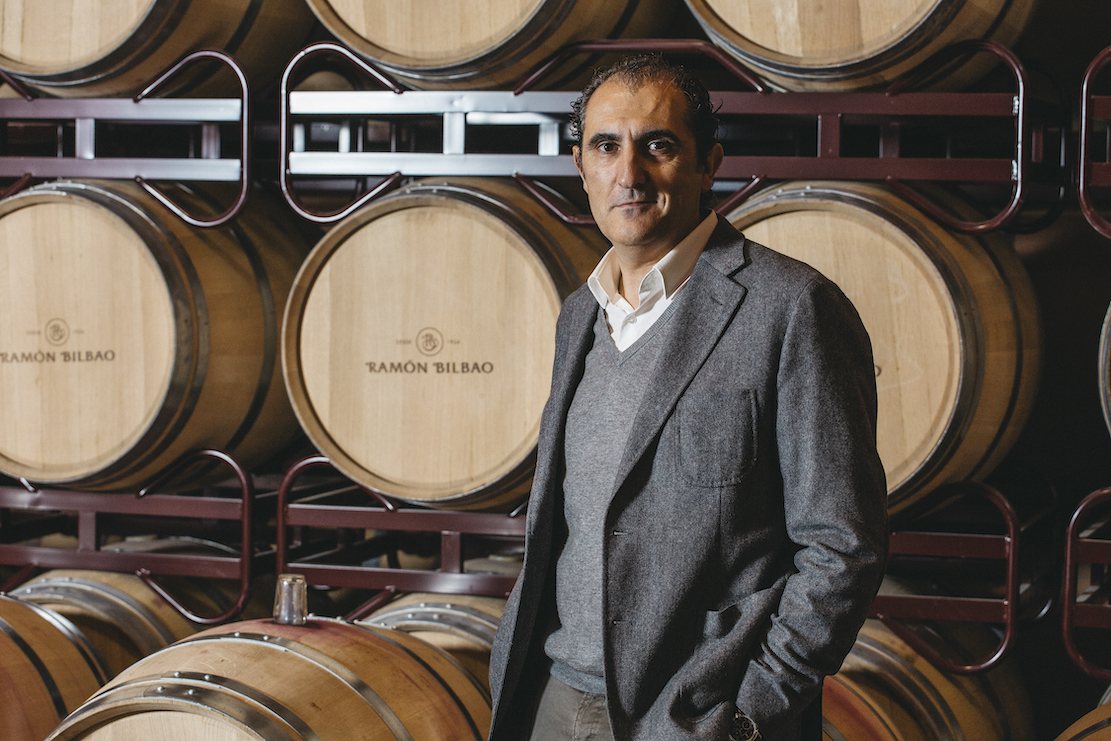 Early
in the 20th century phylloxera devastated
vineyards, then came the Civil War
and World War II, and modern viticutural
techniques like stainless steel took
time to appear in Spain. By the 1960s the industry
was rebounding and
expanding, though many of the tintos (reds)
were
blends without vintage dates until well into the
1990s and more than 30
cooperatives made the abundance of Spanish wine.
In fact, it is still legal to
use up to 15% from another vintage from the one
listed on the label.
Early
in the 20th century phylloxera devastated
vineyards, then came the Civil War
and World War II, and modern viticutural
techniques like stainless steel took
time to appear in Spain. By the 1960s the industry
was rebounding and
expanding, though many of the tintos (reds)
were
blends without vintage dates until well into the
1990s and more than 30
cooperatives made the abundance of Spanish wine.
In fact, it is still legal to
use up to 15% from another vintage from the one
listed on the label.
Probably the only name known to serious wine lovers that would rank with the best French and Italian wines back in the late 1980s was Vega Sicilia, a single estate that later acquired a Rioja appellation.
Rioja, which received DOCA status only in 1991, is now Spain’s leading wine region, with three zones. Bodegas Ramon Bilbao is located in Haro, within the prestigious La Rioja Alta region, spread over 185 acres, with vines averaging 35 years of age. The vineyards are never irrigated, largely non-trellised and hand-harvested. The grapes are 80% Tempranillo with various amounts of Garnacha, Mazuelo and Graciano, and spend time in stainless steel, concrete tanks and oak barrels that are 60% American and 40% French. Production averages 365,000 cases per year.
Rodolfo Bastida (above) has been Technical Director and General Manager of the Bodegas, and has assembled a team with women in top positions—Sara Buñuelos as Technical Director and Rosana Lisa as Director of Innovation and Deputy Technical Director.
I
had the opportunity to interview Bastida over
dinner at New York’s Aretsky’s
Patroon restaurant, where a massive, well-seared
ribeye was the perfect
accompaniment with Ramón Bilbao’s big red wines.
But first we enjoyed an
Albariño, a sprightly white wine (not a Rioja)
with fine minerality and
acidity, usually poured at tapas bars. 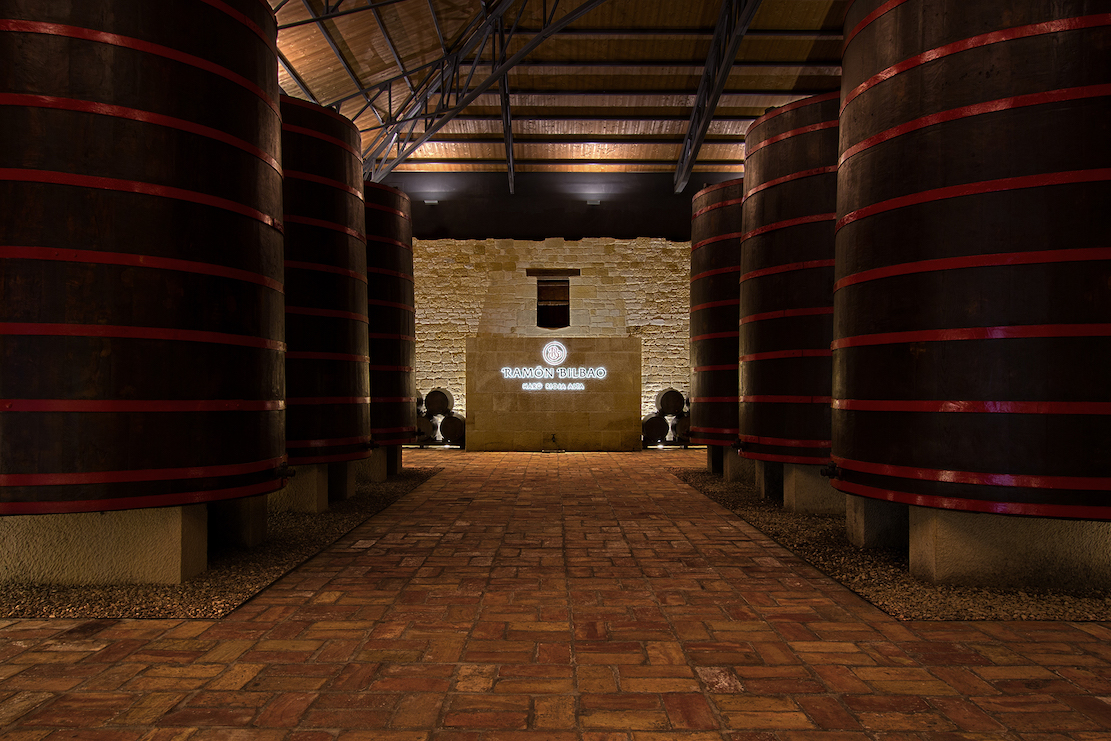
Bastida explained, “Albariño is best known in Galicia,” to which it was probably brought by French Cluny monks as of the 12th century. “The word means `white’ (alba) and `Rhine’ (riño), and is thought to be a clone of Riesling. It grows best in a granite soil, so you get those flinty flavors that make it so refreshing.” Ramón Bilbao’s Albariño sells for only $13.
He also poured a delicious Bilbao Lalomba Rosé ($50), the result of a singular early harvest in 2015 with a very hot summer. “The name means ‛the hill,’ and it’s a single vineyard rosé made from 90% Garnacha and 10% Viura [a Rioja name for the Macabeo]. The high acidity gives it a long life you don’t often see with rosés.”
Bastida was born in Rioja, attained a degree in Technical Agricultural Engineering, a Master’s in Viticulture and Oenology and a Master’s in Business Management. He first worked in an experimental winery in the Cariñena region, then at Domaine Breton before joining Bilbao in 1999, when he innovated growing in higher altitude vineyards than is usual for Tempranillo, which Bastida says gives the varietal more complexity and finesse without losing the boldness that characterizes Riojas.
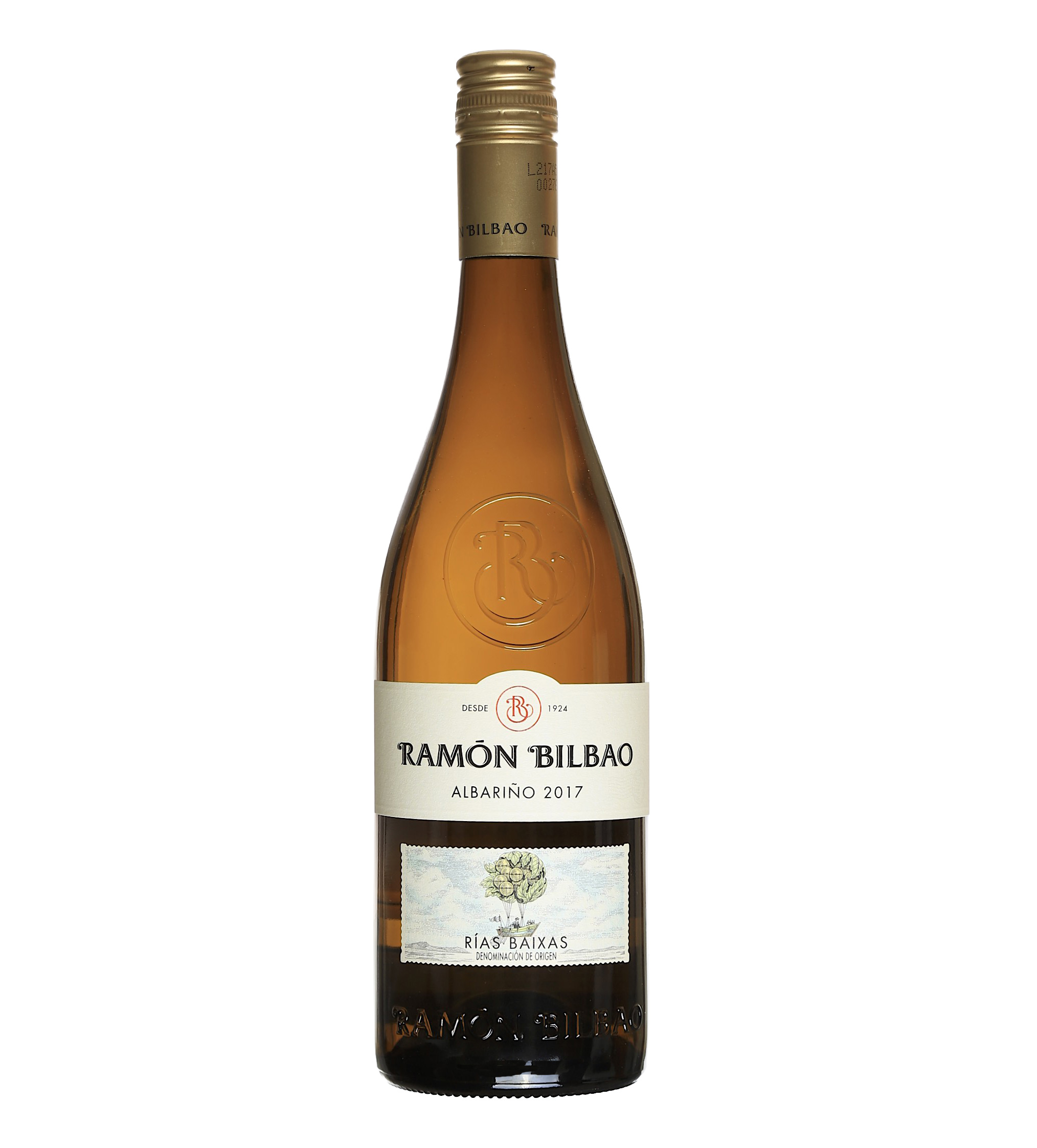 He
says that, “Winemaking can be like painting. You
can use a big brush and a big
pot of one color to obtain something that’s pretty
bland and uninteresting. Or
you can use a small brush, with lots of small pots
of different colors to give
character and complexity.”
He
says that, “Winemaking can be like painting. You
can use a big brush and a big
pot of one color to obtain something that’s pretty
bland and uninteresting. Or
you can use a small brush, with lots of small pots
of different colors to give
character and complexity.”
He has also witnessed how global warming is rapidly changing the way viniculture will be pursued in the future. “My grandfather used to pick 25 days later than we do now,” he said, indicating that the grapes get to full ripeness much earlier than they used to.
The
Rioja Gran Reserva 2011 ($40), made from 90%
Tempranillo, Graciano and Mazuelo,
is big, sensual, voluptuous, yet it has only 14%
alcohol. I told him it is the
Penelope Cruz of Spanish wines.The grapes go
through cold maceration and
fermentation over eight days, then a final nine
days of maceration
on 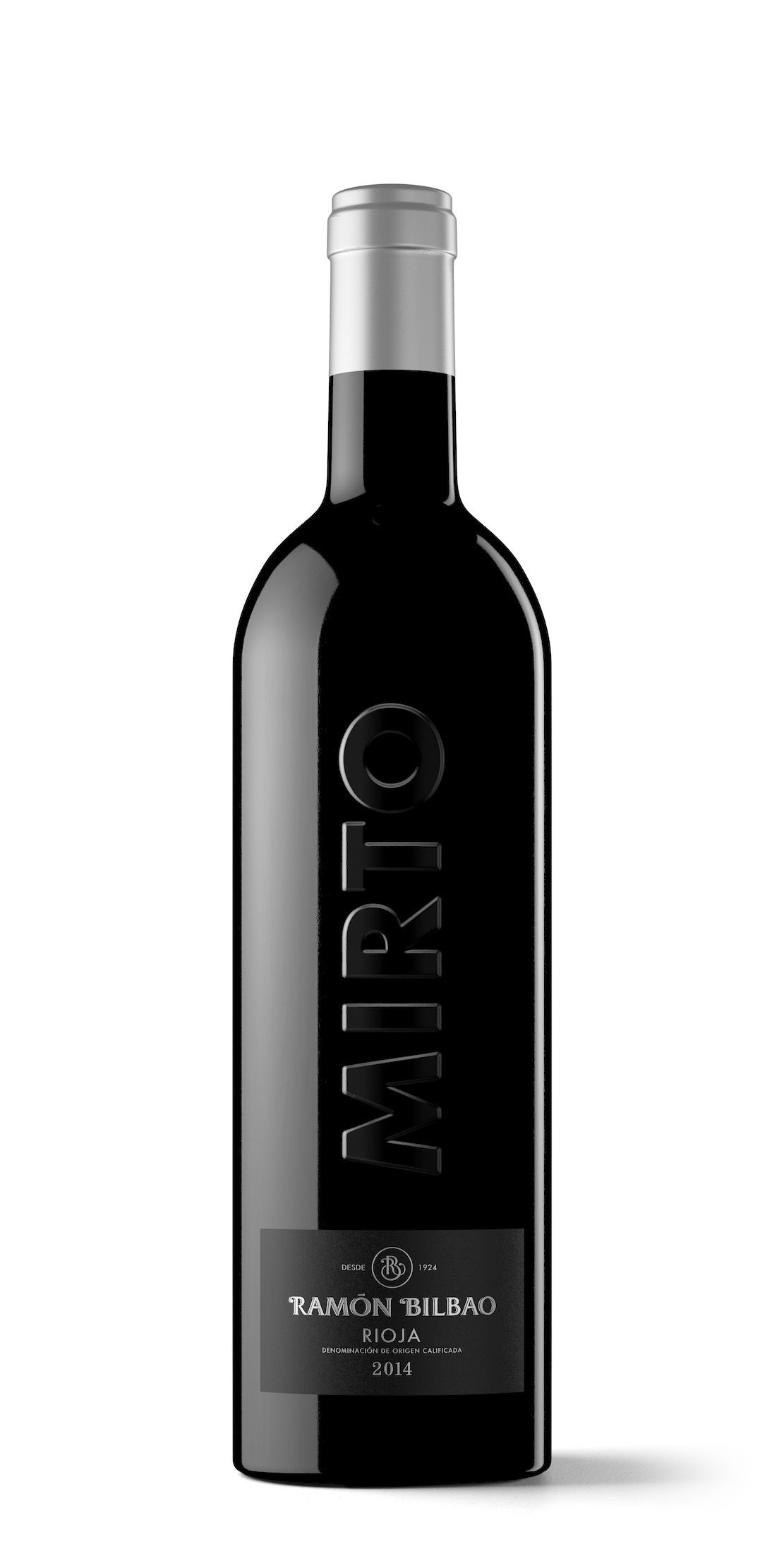 the skins,
then racked
from the stainless steel vats and placed in
American oak barrels for 30 months.
After bottling it spends an additional 36 months
aging.
the skins,
then racked
from the stainless steel vats and placed in
American oak barrels for 30 months.
After bottling it spends an additional 36 months
aging.
One of Bilbao’s more unusual wines is called Mirto, meaning “myrtle,” made from 100% Tempranillo. We sampled the 2014 vintage ($65) and one from 1999 (Bastida’s first, no longer available), about which he waxes poetic: “We feel the beat of things from the heart. We pump our dream, now converted into wine, from our stock into your glass. A wine inside, from the deepest part of our homeland, from what truly moves us.” Maybe so, but what I tasted were two very beautiful wines with their own character.
The 2014 harvest went very well, with grapes showing heterogeneous ripeness. It spent 19 months in new French Allier oak casks and was bottled without any fining or filtering, which certainly explains the rich, deep character. The 1999 had aged impressively, and still is evolving, tasting of wine whose every element of tannin, fruit and acid have melded into an intense velvety rush that envelops the palate and lasts a long time in the finish.
Despite its output, Ramon Bilbao wines have achieved an international reputation and sell a good amount in the U.S. and a small amount in China. I asked Bastida if China was going to be an expanding market for Spanish wines. Like many vintners I’ve asked the same question, he shrugged, wary of all the vagaries of cultural differences and economic forces in constant flux. “I will tell you this,” he said. “The U.S. buys wines and drinks them; the Chinese buy prestige wines to show off and the rest to drink with ice cubes and Coca-Cola.”
❖❖❖

OUR
SENTIMENTS EXACTLY
"It is
a badly kept secret among us coddled, gouty,
52-columns-a-year restaurant critics that we fear and
avoid the lengthy, fine-dining tasting menu. No fact
sends onlookers into more effervescent conniptions.
But it’s not that we’re ungrateful for, say, our tiny
amuse-bouches of blow-torched mallard lamella with a
12-hour Izumo Province nori reduction, or its delivery
under cloche with all the rapidity of Julie
Walters serving up two soups. No, it’s just that we have to do that
kind of thing a lot, and it’s often done badly: too
pompous, too many petals, too few carbs, not a lot of
laughs."--Grace Den (left),
"Xier," The
Guardian (March 2019).
WRETCHED
EXCESS NO. 4,557
The Grand Hyatt Tokyo is has created a $900 hamburger
named the Golden Giant Burger, 10 inches in diameter,
weighing 2.2 pounds, topped with kuroge wagyu steak, foie
gras, truffles, two onions, lettuce, tomatoes, and
cheddar cheese, and finished with a gold
powder-infused bun on top, all costing $150 per
person.
Wine
Column Sponsored by Banfi Vintners
SANGIOVESE
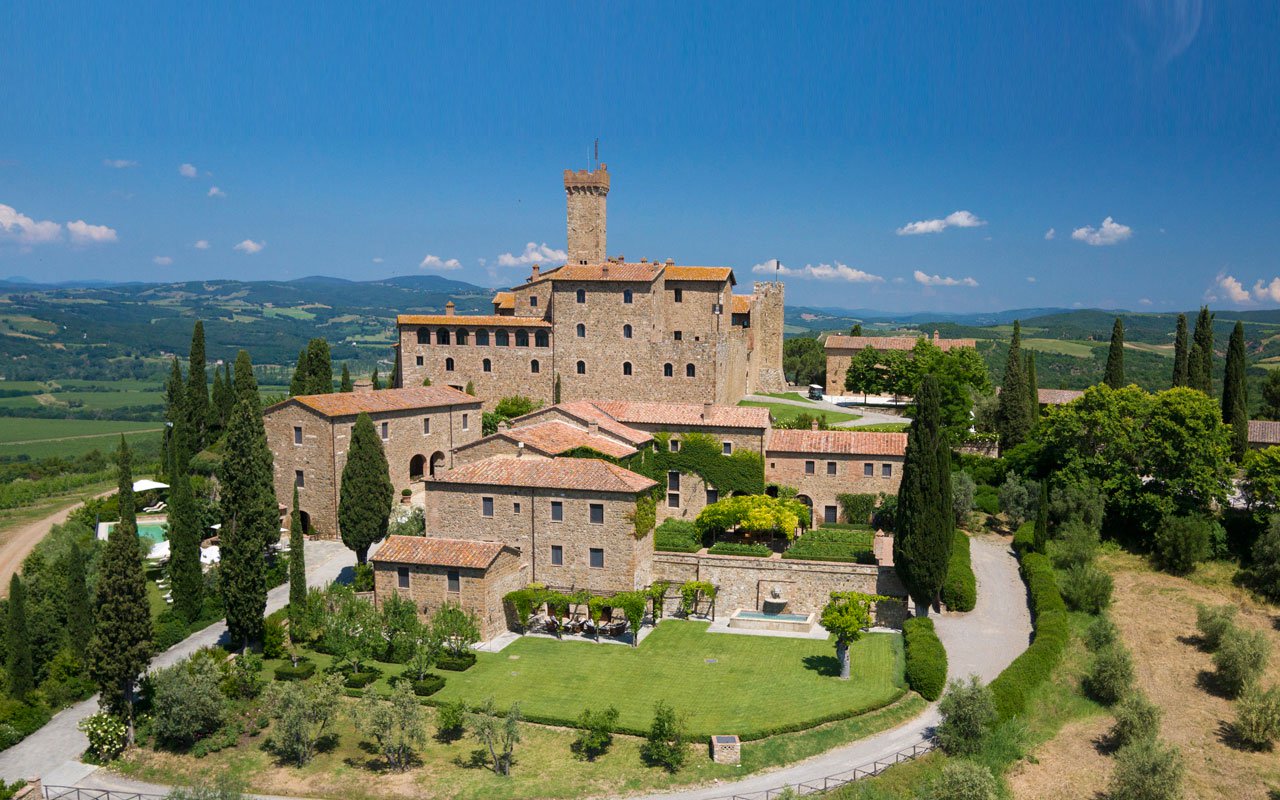 Wine is a joy year-round but
in cooler weather one
grape varietal has really taken center stage in
my daily activities – that most Italian of
grapes, Sangiovese, and its ultimate expression
– Brunello di Montalcino.
Wine is a joy year-round but
in cooler weather one
grape varietal has really taken center stage in
my daily activities – that most Italian of
grapes, Sangiovese, and its ultimate expression
– Brunello di Montalcino.
From mid-September through mid-October,
the Sangiovese grown for our various styles of red
wines are be harvested, culminating with the top
selection for Brunello di Montalcino.
Second, cooler weather here means
it is time to start enjoying more red wines and
especially Sangiovese based wines. That
includes Banfi’s cru of Brunello, Poggio alle Mura,
literally the cream of the crop of our Sangiovese
vineyards. Alongside our Poggio alle Mura Brunello di
Montalcino, this year we introduced two more wines
from the cru Poggio alle Mura – a Rosso di Montalcino
and a Riserva of Brunello. Rosso is sort of like the
younger brother of Brunello, also made from 100%
Sangiovese grapes but usually a selection from younger
vines and the wine is aged only two years compared to
the four required for Brunello. The
Riserva, on the other hand, is an even more selective
harvest of Sangiovese, and ages for an additional year
before release.
What is so special about this cru
Poggio alle Mura?
Well, it is the result our over 30 years of
ongoing research at my family’s vineyard estate,
Castello Banfi.
When we first began planting our vines there in
the late 1970s studies from the University of Bordeaux
indicated which strains of many varietals we should
plant, based on the soil type and microclimate of each
vineyard. But
when it came to the region’s native Sangiovese, there
was only local lore, no scientific research. So we took
it upon ourselves to figure out this vine, and set off
on three decades of incredibly detailed research.
We started
with 600 apparent variations on Sangiovese, because it
is so susceptible to variations in weather and soil,
and narrowed that down to 160 truly genetically
different clones.
We planted a vineyard with two rows of each
type, made wine from each of them, and charted the
differences – remember, you only get one chance a year
to make wine, so this took time.
It took about ten years to get some
concrete results, though we continue to experiment
today and always will – you never stop learning in
science and nature!
Once we determined which were the best,
complementary clones that could be planted together to
make the best Brunello, we chose to plant them in what
we determined to be the optimal vineyard sites. Coincidentally,
the best soils and climate conditions are in the
slopes surrounding the medieval fortress today known
as Castello Banfi, known since Etruscan times as
Poggio alle Mura – the walled hilltop. Hence the
name of our most special “cru” of Brunello,
representing a synthesis between tradition and
innovation.
Though the focus of this study was
our Brunello, all of our Sangiovese-based wines,
including the super Tuscans SummuS, Cum Laude, and
Centine, benefitted from this work. And that’s
the third reason for celebrating Sangiovese this
month, for the range of wonderful reds that usher us
into autumn! One
wine in particular was inspired by our research – the
BelnerO, a Sangiovese dominant blend with what I like
to call a kiss of Cabernet and a whisper of Merlot. We grow the
grapes a little differently for BelnerO than for
Brunello, make the wine with less oak aging and
released it earlier from the winery, providing a
counterpoint to Brunello and a lovely terroir-driven
wine in its own right.
If you
know Italians, you know that by nature we are
multi-faceted, varying in mood, and always passionate. As a
nation, we span from the hot sunny beaches of Sicily
near the African coast to the rugged mountains and
Alpine ski slopes of Trentino-Alto Adige in the north. Sangiovese
is grown in almost all of Italy’s regions and reflects
the unique nature of each; it is most famous
(rightfully so) in Tuscany, yet even there it reflects
the nuances of each hilltop, valley and subzone. It has
something a little different to say in Brunello than
Chianti, Morellino than Vino Nobile di Montepulciano,
Rosso di Montalcino than Super Tuscan blends.
Here is a smattering of
Sangiovese-based wines that you may wish to get to
know better, reflecting a spectrum that appeals to
every occasion, every taste, and every budget. We can
assure you that the conversation will never become
boring. 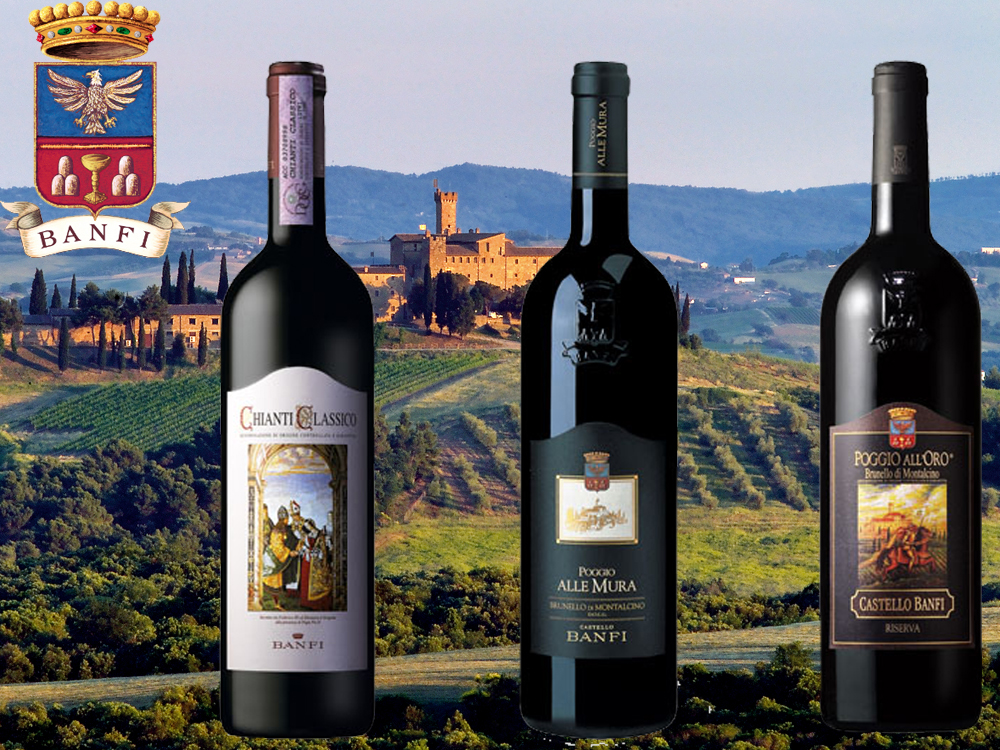
Recommendations for Celebrating
Sangiovese
BelnerO Proprietor’s Reserve Sangiovese
– A refined
cuvée of noble red grapes perfected by our pioneering
clonal research. This dark beauty, BelnerO, is
produced at our innovative winery, chosen 11
consecutive years as Italy’s Premier Vineyard Estate.
Fermented in our patented temperature controlled
French oak and aged approximately 2 additional years.
Unfiltered, and Nitrogen bottled to minimize sulfites.
Castello Banfi Brunello di Montalcino –
Rich, round, velvety and intensely
aromatic, with flavor hints of licorice, cherry, and
spices. Brunello di Montalcino possesses an intense
ruby-red color, and a depth, complexity and opulence
that is softened by an elegant, lingering aftertaste.
Unfiltered after 1998 vintage.
Castello Banfi Rosso di Montalcino – Brunello's "younger brother," produced
from select Sangiovese grapes and aged in barrique for
10 to 12 months. Deep ruby-red, elegant, vibrant,
well-balanced and stylish with a dry velvety
finish.
Poggio all’Oro Brunello di Montalcino
Riserva – A single vineyard selection of our most
historically outstanding Sangiovese, aged five years
before release, the additional year more than that
required of Brunello including 6 months in barrel and
6 months more in bottle to grant its “Riserva”
designation. Incredible
elegance and harmony. Intense with lots of fruit and
subtle wood influence. Round, complete, well balanced
with hints of chocolate and berries. Unfiltered after
1998.
Poggio alle Mura – The first tangible result of years of
intensive clonal research on Montalcino’s native
Sangiovese grape.
Estate bottled from the splendidly sun drenched
vineyards surrounding the medieval Castello from which
it takes its name.
The Brunello
di Montalcino is seductive, silky and smoky. Deep ruby
in color with an expressive bouquet of violets, fruits
and berries as well as cigar box, cedar and exotic
spices. The Rosso
di Montalcino is also intense ruby red. The bouquet
is fresh and fruity with typical varietal notes of
cherry and blackberry, enriched by more complex hints
of licorice, tobacco and hazelnut. It is full
bodied, yet with a soft structure, and a surprisingly
long finish. The Poggio alle Mura Brunello di Montalcino
Riserva is deep ruby red with garnet
reflections and a rich, ample bouquet that hints of
prune jam, coffee, cacao and a light balsamic note. It is full
and powerful, with ripe and gentle tannins that make
it velvety and harmonious; this wine is supported by a
pleasing minerality that to me speaks soundly of that
special hillside in southern Montalcino.
SummuS – A wine of towering elegance, SummuS is an
extraordinary blend of Sangiovese which contributes
body; Cabernet Sauvignon for fruit and structure; and
Syrah for elegance, character and a fruity bouquet. An elegant,
complex and harmonious red wine.
Cum Laude – A complex and elegant red which graduated
“With Honors,” characterized by aromas of juicy
berries and fresh spices.
Centine – A Cuvee that is more than half
Sangiovese, the balanced consisting of equal parts of
Cabernet Sauvignon and Merlot. Vinified in
a firm, round style that easily accompanies a wide
range of dishes, this is a smooth and fragrantly
satisfying wine with international character, and a
perennial favorite at my own dinner table.
Banfi Chianti Superiore – The “Superiore” designation signifies
stricter government regulations regarding production
and aging requirements, as compared to regular
Chianti. An
intense ruby red wine with fruit forward aromas and
floral notes. This
is a round wine with well-balanced acidity and fruit.
Banfi Chianti Classico – An enduring classic: alluring
bouquet of black fruit and violets; rich flavors of
cherry and leather; supple tannins and good acidity
for dining.
Banfi Chianti Classico Riserva – Produced from select grapes grown in the
"Classico" region of Chianti, this dry, fruity and
well-balanced red has a full bouquet reminiscent of
violets.
Fonte alla Selva Chianti Classico – This is our newest entry into the Chianti
arena, coming from a 99 acre estate in Castellina, the
heart of the Chianti Classico region. The wine is
a captivating mauve red that smells of cherry, plum
and blackberry with hints of spice. It is
round, full and balanced with very good
acidity.
Col di Sasso – Sangiovese and Cabernet Sauvignon. Luscious,
complex and soft with persistent notes of fruit and
great Italian style structure.
Any of John Mariani's books below may be ordered from amazon.com.
 The Hound in Heaven
(21st Century Lion Books) is a novella, and
for anyone who loves dogs, Christmas, romance,
inspiration, even the supernatural, I hope you'll find
this to be a treasured favorite. The story
concerns how, after a New England teacher, his wife and
their two daughters adopt a stray puppy found in their
barn in northern Maine, their lives seem full of promise.
But when tragedy strikes, their wonderful dog Lazarus and
the spirit of Christmas are the only things that may bring
his master back from the edge of despair.
The Hound in Heaven
(21st Century Lion Books) is a novella, and
for anyone who loves dogs, Christmas, romance,
inspiration, even the supernatural, I hope you'll find
this to be a treasured favorite. The story
concerns how, after a New England teacher, his wife and
their two daughters adopt a stray puppy found in their
barn in northern Maine, their lives seem full of promise.
But when tragedy strikes, their wonderful dog Lazarus and
the spirit of Christmas are the only things that may bring
his master back from the edge of despair. WATCH THE VIDEO!
“What a huge surprise turn this story took! I was completely stunned! I truly enjoyed this book and its message.” – Actress Ali MacGraw
“He had me at Page One. The amount of heart, human insight, soul searching, and deft literary strength that John Mariani pours into this airtight novella is vertigo-inducing. Perhaps ‘wow’ would be the best comment.” – James Dalessandro, author of Bohemian Heart and 1906.
“John Mariani’s Hound in Heaven starts with a well-painted portrayal of an American family, along with the requisite dog. A surprise event flips the action of the novel and captures us for a voyage leading to a hopeful and heart-warming message. A page turning, one sitting read, it’s the perfect antidote for the winter and promotion of holiday celebration.” – Ann Pearlman, author of The Christmas Cookie Club and A Gift for my Sister.
“John Mariani’s concise, achingly beautiful novella pulls a literary rabbit out of a hat – a mash-up of the cosmic and the intimate, the tragic and the heart-warming – a Christmas tale for all ages, and all faiths. Read it to your children, read it to yourself… but read it. Early and often. Highly recommended.” – Jay Bonansinga, New York Times bestselling author of Pinkerton’s War, The Sinking of The Eastland, and The Walking Dead: The Road To Woodbury.
“Amazing things happen when you open your heart to an animal. The Hound in Heaven delivers a powerful story of healing that is forged in the spiritual relationship between a man and his best friend. The book brings a message of hope that can enrich our images of family, love, and loss.” – Dr. Barbara Royal, author of The Royal Treatment.
 |
The Encyclopedia of American Food and Drink by John F. Mariani (Bloomsbury USA, $35) Modesty forbids me to praise my own new book, but let me proudly say that it is an extensive revision of the 4th edition that appeared more than a decade ago, before locavores, molecular cuisine, modernist cuisine, the Food Network and so much more, now included. Word origins have been completely updated, as have per capita consumption and production stats. Most important, for the first time since publication in the 1980s, the book includes more than 100 biographies of Americans who have changed the way we cook, eat and drink -- from Fannie Farmer and Julia Child to Robert Mondavi and Thomas Keller. "This book is amazing! It has entries for everything from `abalone' to `zwieback,' plus more than 500 recipes for classic American dishes and drinks."--Devra First, The Boston Globe. "Much needed in any kitchen library."--Bon Appetit. |
"Eating Italian will never be the same after reading John Mariani's entertaining and savory gastronomical history of the cuisine of Italy and how it won over appetites worldwide. . . . This book is such a tasteful narrative that it will literally make you hungry for Italian food and arouse your appetite for gastronomical history."--Don Oldenburg, USA Today. "Italian
restaurants--some good, some glitzy--far
outnumber their French rivals. Many of
these establishments are zestfully described
in How Italian Food Conquered the World, an
entertaining and fact-filled chronicle by
food-and-wine correspondent John F.
Mariani."--Aram Bakshian Jr., Wall Street
Journal.
"Equal parts
history, sociology, gastronomy, and just
plain fun, How Italian Food Conquered the
World tells the captivating and delicious
story of the (let's face it) everybody's
favorite cuisine with clarity, verve and
more than one surprise."--Colman Andrews,
editorial director of The Daily
Meal.com. "A fantastic and fascinating
read, covering everything from the influence
of Venice's spice trade to the impact of
Italian immigrants in America and the
evolution of alta cucina. This book will
serve as a terrific resource to anyone
interested in the real story of Italian
food."--Mary Ann Esposito, host of PBS-TV's
Ciao
Italia. "John Mariani has written the
definitive history of how Italians won their
way into our hearts, minds, and
stomachs. It's a story of pleasure over
pomp and taste over technique."--Danny Meyer,
owner of NYC restaurants Union Square
Cafe, The Modern, and Maialino.
|
 |
 |
 |
 |
 |
 |
 |
 |
 Everett Potter's Travel Report:
Everett Potter's Travel Report: 
 Eating Las Vegas
JOHN CURTAS has been covering the Las Vegas
food and restaurant scene since 1995. He is
the co-author of EATING LAS VEGAS – The 50
Essential Restaurants (as well as
the author of the Eating Las Vegas web site: www.eatinglasvegas.
He can also be seen every Friday morning as
the “resident foodie” for Wake Up With the
Wagners on KSNV TV (NBC) Channel 3 in
Las Vegas.
Eating Las Vegas
JOHN CURTAS has been covering the Las Vegas
food and restaurant scene since 1995. He is
the co-author of EATING LAS VEGAS – The 50
Essential Restaurants (as well as
the author of the Eating Las Vegas web site: www.eatinglasvegas.
He can also be seen every Friday morning as
the “resident foodie” for Wake Up With the
Wagners on KSNV TV (NBC) Channel 3 in
Las Vegas.
MARIANI'S VIRTUAL GOURMET
NEWSLETTER is published weekly. Publisher: John Mariani. Editor: Walter Bagley. Contributing Writers: Christopher Mariani,
Robert Mariani, Misha Mariani, John A. Curtas, Gerry Dawes, Geoff Kalish,
and Brian Freedman. Contributing
Photographer: Galina Dargery. Technical
Advisor: Gerry
McLoughlin.
If you wish to subscribe to this
newsletter, please click here: http://www.johnmariani.com/subscribe/index.html
© copyright John Mariani 2019

